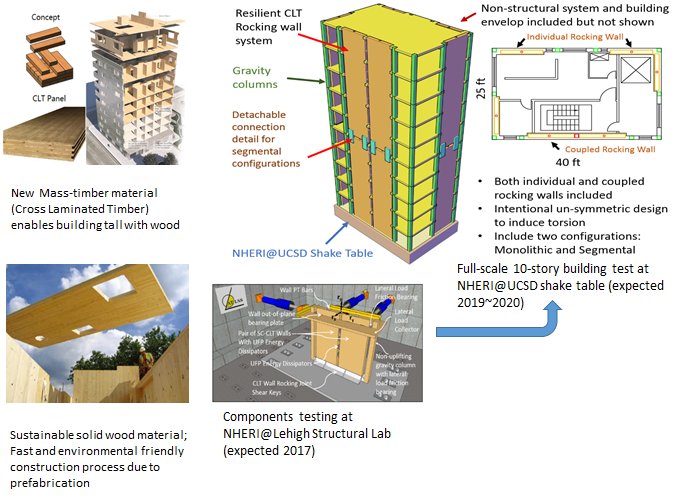CMMI 1635227 - PI James Ricles, Lehigh University; co-PI Richard Sause, Lehigh University
CMMI 1636164 - PI Shiling Pei, Colorado School of Mines
CMMI 1635156 - PI James Dolan, Washington State University
As the U.S. population continues to grow in urban communities, the demand for tall residential and mixed-use buildings in the range of eight to twenty stories continues to increase. Buildings in this height range are commonly built using concrete or steel. A recent new timber structural innovation, known as cross laminated timber (CLT), was developed in western Europe and is now being implemented around the world as a sustainable and low carbon-footprint alternative to conventional structural materials for tall buildings. However, an accepted and validated design method for tall CLT buildings to resist earthquakes has not yet been developed, and therefore construction of these tall wood buildings in the United States has been limited. This research will break this barrier by investigating a seismic design methodology for resilient tall wood buildings that can be immediately re-occupied following a design level earthquake and quickly repaired (compared to current building systems) after a large earthquake. Using the seismic design methodology developed in this project, the research team will work with practitioners across the engineering and architectural communities to design, build, and validate the performance of a ten-story wood building by conducting full-scale sub-assembly system testing at the National Science Foundation (NSF)-supported Natural Hazards Engineering Research Infrastructure (NHERI) experimental facility at Lehigh University, followed by full-scale tests at the NSF-supported NHERI outdoor shake table at the University of California at San Diego. This research will enable a new sustainable construction practice that is also cost-competitive, thereby increasing demands for engineered wood production, providing added value for forest resources, and enhancing job growth in the construction and forestry sectors. As part of the research, the experimental programs will serve to provide outreach to the public and stakeholders on issues related to seismic hazard mitigation, modern timber engineering, and resilient building concepts.
The goal of this research is to investigate and validate a seismic design methodology for tall wood buildings that incorporates high performance structural and non-structural systems. The methodology will quantitatively account for building resilience. This will be accomplished through a series of research tasks planned over a four-year period. These tasks will include mechanistic modeling of tall wood buildings with several variants of post-tensioned rocking CLT wall systems, fragility modeling of structural and non-structural building components that affect resilience, full-scale bi-directional testing of building sub-assembly systems, development of a resilience-based seismic design methodology, and finally a series of full-scale shake table tests of a ten-story CLT building specimen to validate the investigated design. The structural systems investigated will include post-tensioned CLT rocking walls in both monolithic and segmental rocking configurations. Implementing segmental rocking walls in a full building system will be a transformative concept that has yet to be realized physically. The rocking wall systems will be investigated under the context of holistic building behavior, including gravity systems and non-structural components. The research team will further push the boundary of existing performance-based seismic design by developing a design procedure that explicitly considers the time needed for the building to resume functionality after an earthquake. With the large-scale testing capacity provided by the NHERI experimental facilities, the design methodology will be experimentally validated, which will at the same time generate a landmark data set for tall wood buildings under dynamic loading that will be available to the broader research and practitioner community through the NHERI DesignSafe-ci.org Data Depot. The project will facilitate implementation of this new structural archetype by interfacing closely with practitioners in the Pacific Northwest interested in tall CLT buildings as a cost-competitive design option. Graduate and undergraduate students, including community college students, will actively participate in this research and gain valuable knowledge and experience, which will prepare them to become leaders in sustainable building practices using modern engineered wood materials.
